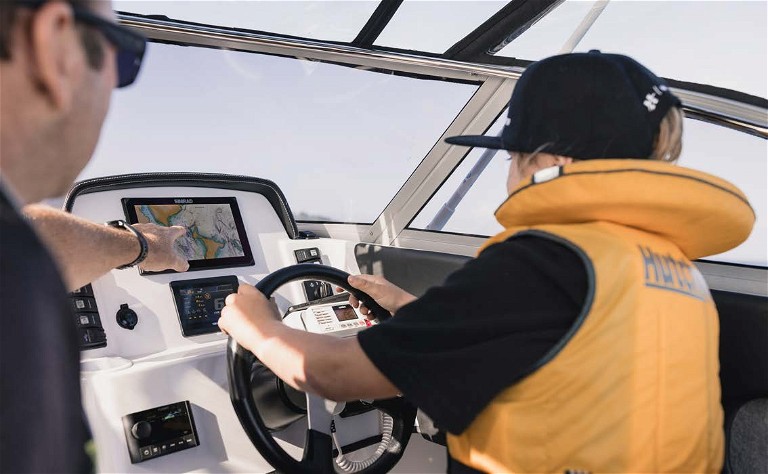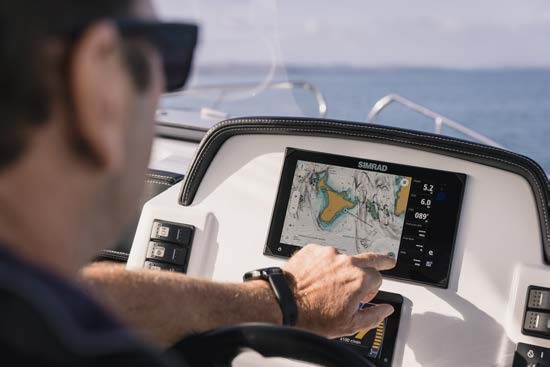SIMRAD NSX KEEPING IT SIMPLE

Navico’s designers have aced their goal of making the recently released Simrad NSX chartplotter/sounder as simple as possible.
We have all heard of the KISS theory, right? Keep It Simple Stupid! Well, Navico’s electronics engineers must have used it as their catchphrase when developing the new SimradNSX chartplotter/ fishfinder because it is so simple and easy to use.
Readers will notice that this is headed a review, not a test. The simple reason is that it’s not written following on-the-water experience, but from using a simulator.
Thwarted several times by the weather to get out on a Haines Hunter 545 that has the gear on board, my other option was to run through its functionality with product director Matt Hooper and marketing director Mike Blackwell at Navico’s North Shore HQ.
For the NSX, Navico has developed a whole new operating system, starting with a blank canvass and redesigning everything from the ground up. The result is a technology that is “simple to use, but not simplistic,” as Mike put it.
“It is not any one big thing, but a whole raft of smaller aspects that make this unit what it is,” Mike said.
There are over 100 small things the designers have improved upon, based on extensive customer surveys. With a brand new chart from C-Map, Navico is claiming to have the world’s best charts on this product, which they are immensely proud of. Having seen it in operation, I can concur.
The NXS has re-imagined the role of a chart plotter and sounder for consumers, right from when it’s taken out of the box.
You first notice the minimal screen surround, or ‘frit’ to give it its technical handle.
Available in 7, 9, and 12-inch screens, the real estate goes right to the very edge of the unit, maximising its helm station space. The Solar Max screens are viewable from any angle, in direct sunlight, and with polarised glasses.
Matt says the product was designed specifically for the weekend or occasional boater.
“The NSX is intuitive to use, starting with the Setup Wizard that walks users through the process. Anyone familiar with a mobile phone will appreciate that many of the settings and layout are familiar,” Matt says.
The second thing is, no buttons. Everything is done using the touch screen. Setting up multiple screen configurations is easy, as is saving your favourites. The instrument bar is fully editable – you make the call about what you want to display. NSX interfaces easily with radar and autopilot. In the night view, there is a hard line around the land masses, a practical safety feature.
The new C-Map Discover X and Reveal X cartography are seamless and fast, featuring a full New Zealand chart. The highlevel bathymetry shows accurate contour lines down to 0.3m detail.
One of the functions I like is the ease at which you sound an area and mark fish – with some units, the depth sounder stops and freezes. With the NSX, the sounder continues to give you a current bottom and fish reading.
Other little things make life easier for the helmsperson. For example, when selecting from the menu high or low-frequency settings for the sounder, a little information bar pops up, explaining the advantages of choosing that option. That info is found throughout the various functions.
The waypoint list can be filtered in several ways – today’s, last week’s, last year’s, by date, and even fish species.
“Anglers can colour code their marks by species or season, which is easy to record and retrieve,” Matt explained.
Another cool feature is the Waypoints and Routes app. When you tap on a waypoint, it comes up with a zoomed-in chart shot along with other information, including any notes you may have made when first logging the mark. Over time it becomes something of an electronic fishing diary.
“If you are planning a winter snapper trip and haven’t been on the water for a while, you would filter your marks by the season and the colour, the latter representing the species. These would then show up on the screen, giving you options that have worked for you in the past. Other notes you have inputted, such as ‘Fishes best last two hours of the tide’, further narrows down your choice for the day, saving you time searching for new grounds.”
Much pre-trip planning can be done at home via the Simrad companion phone application, saving you time at the dock.
Working out a route for longer trips can be configured before you hit the water. Pre-loaded vessel information such as length, beam, height, draft, and cruising speed is accounted for when planning a safe route from one point to another with the super-fast autorouting feature.
Regardless of how you like your chart presented – course, north, or heading up – it’s easy to change by just tapping on the icon at the bottom corner of the screen. While this is not a major feature, it is indicative of just how easy the NSX is to use.
I spent 90 minutes pouring over the unit’s functionality with Matt and Mike, and while we touched on the main features, there are many others we did not get to. They are not hard to discover and execute – it’s just that there are so many of them to cover in the time available and the space for this review!
The units range in cost from $2399 for the 7“ model, to $2999 for the 9”, and up to $5449 for the 12”. All come with Active Imaging and C-Map Discover X charts for Australia and NZ.
Summing up, while I can’t comment on the unit’s on-water performance, I can say I have never come across marine electronics that are as functional and easy to use as the Simrad NSX. I have the Simrad NSS Evo 3 on my own boat, Tackle Tester, and so can appreciate how much easier it is to use the new NSX.
For more details go to www. simrad-yachting.com/nsx.
– Grant Dixon

Both weekend family boaties and more serious anglers will appreciate the functionality of the new Simrad NSX.

If you can negotiate yourself around an iPhone then this new kit from Simrad will be child’s play.

Everything is at your fingertips on a touch screen that can be clearly viewed from various angles and light settings.